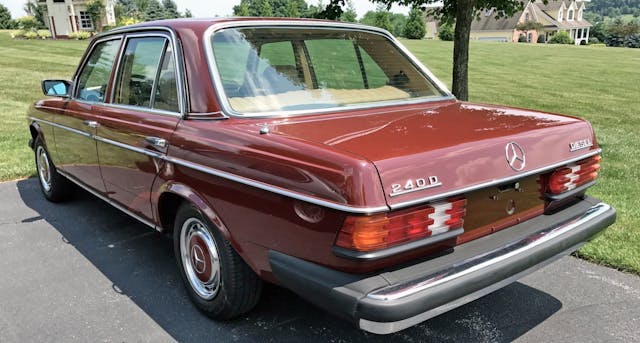The Mercedes-Benz 240D has always been for outsiders
As a vehicle slips down its depreciation curve, the change in buyer demographics is both expected and anticipated. Socioeconomically speaking, most societies value new products over those made just a few years ago. The people who make luxury cars, in some sense, must hope their creations live a charmed and beloved life from start to finish. This would seem to be especially true of 1970s and ’80s Mercedes-Benzes, which were known for their superior engineering and impressive craftsmanship.
The W123 was a premium vehicle for people that didn’t want a stereotypical premium ride of the era. And if you looked at the W123 lineup and selected the oil-burning 240D, it meant your taste for the atypical was particularly keen.
Back in the day, the folks at Motorweek got their hands on a fine example of diesel-powered German engineering and totally nailed the lede with a successful businessperson award. This teed up the W123 for a brilliantly contextualized review. Sure, it’s expensive ($22,500 in 1983, or about $62,000 in 2021) even as an entry level Merc, but prestige alone isn’t why some people lusted after them. And in the case of Motorweek’s example: desirable as humanly possible in luscious brown paint, with a diesel engine and a four-speed manual transmission!

Everyone knows how well Mercedes-Benz products were made in this era, and how much attention went into ensuring W123’s felt high-quality in every nook and cranny. The seats were comfortable for any body shape, wood veneers were endlessly deep, and the feeling was distinctly luxurious without being decadent and massive a la American luxury machines.

The OM616 diesel engine was noted for its supreme simplicity in the era of rudimentary computer-controlled fuel delivery for gasoline engines. The lack of power didn’t stop aspirational purchases of those who remember the lines at gasoline stations from just a few years ago, so perhaps Motorweek’s “sprint” to sixty in 22 seconds was actually time well spent for the driver. But as time marched on, even as the W123’s replacement was light years ahead in terms of technology, the little 240D remained magical even as it slipped further down the depreciation curve.
The diesel W123s, such as the modest 240D, managed to thrive even as they found newer owners with smaller budgets. This proved true despite the hefty cost (relative to a Ford/GM based luxury car) of replacement parts, a more limited selection of qualified mechanics, and a dealer network that was far from the experience Lexus pioneered in 1990. And sometime in the mid-1990s, when the notion of biofuels became a regional reality for many Americans, the W123 diesel Mercedes—nearing the bottom of its depreciation curve—came back into the spotlight for all the right reasons. In doing so, it found favor with even more potential owners.
And so here we are today, a time when the workmanlike 240D is a full-on classic car with unquestionable durability, modest luxury, analog interfaces, diesel swagger, and a Mercedes-Benz three-pointed star atop its hood. Hagerty valuation suggests that 240Ds in #3 (Good) condition are worth around $10,000, while a #1 (perfect Concours condition) example trades for $35,000. The latter is still only $12,700 in 1983 dollars, but consider its rate of deprecation/resale value relative to other luxury sedans from the same era; there’s no doubt that folks who bought 240D new, and those that now consider them alternative-fuel classics, have made the Mercedes-Benz 240D an enduring example of premium transportation. So if you don’t get it, it’s simply not meant for you.


